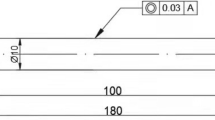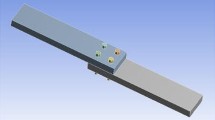Abstract
Bolted connections are widely used in the machine tool manufacturing and equipment. As it is well known, bolt preload will be attenuated by the vibration of machine tools, which will degenerate the working life of machine tools. In this paper, a new experimental design method is introduced into the study on bolt preload attenuation: the quadratic general rotary unitized design. The dynamic analysis of the bolted connection is carried out based on a finely fragmented numerical model to interpret the generation of fretting slip and the reason for the loosening of bolts. The alternating load cyclic vibration test, implemented on the bolted joints, can provide the vibration response under the influence of different working factors. Statistical test and analysis are performed on the quadratic regression mathematical model of the bolt preload attenuation, and the principal working factor that affecting the bolt preload attenuation under vibration can be obtained. Based on the analytical result, the combination of the working factors at the lowest bolt preload attenuation rate, which can effectively slow the bolt looseness, is investigated. The results of this study can provide an experimental basis for improving the machining stiffness of machine tools.









Similar content being viewed by others
Data availability
Not applicable.
References
Guo T et al (2012) Alternative method for identification of the dynamic properties of bolted joints. J Mech Sci Technol 26(10)
Gao X et al (2016) Stiffness modeling of machine tools based on machining space analysis. Int J Adv Manuf Technol 86:1–14
Cheng Q, Qi B, Liu Z, Zhang C, Xue D (2019) An accuracy degradation analysis of ball screw mechanism considering time-varying motion and loading working conditions. Mech Mach Theory 134:1–23. https://doi.org/10.1016/j.mechmachtheory.2018.12.024
Jiang Y, Zhang M, Park TW, Lee CH (2004) An Experimental Study of Self-Loosening of Bolted Joints. J Mech Des 126:925–931
Caccese V, Berube KA, Fernandez M, Daniel Melo J, Kabche JP (2009) Influence of stress relaxation on clamp-up force in hybrid composite-to-metal bolted joints. Compos Struct 89:285–293
Zhang X, Yu HP, Su H, Li CF (2016) Experimental evaluation on mechanical properties of a riveted structure with electromagnetic riveting. Int J Adv Manuf Technol 83(9-12):2071–2082
Junker GH (1972) Criteria for self loosening of fasteners under vibration. Aircr Eng Aerosp Technol 44:14–16
Daadbin A, Chow YM (1992) A theoretical model to study thread loosening. Mech Mach Theory 27:69–74
Housari BA, Nassar SA (2007) Effect of Thread and Bearing Friction Coefficients on the Vibration-Induced Loosening of Threaded Fasteners. J Vib Acoust 129:484–494. https://doi.org/10.1115/1.2748473
Biswas S, Chatterjee A (2018) A two-state hysteresis model for bolted joints, with minor loops from partial unloading. Int J Mech Sci 140:506–520. https://doi.org/10.1016/j.ijmecsci.2018.03.021
Dean C, Ma Y (2019) Tightening behavior of bolted joint with non-parallel bearing surface. Int J Mech Sci
Zadoks RI, Yu X (1997) An investigation of the self-loosening behavior of bolts under transverse vibration. J Sound Vib 208:189–209
Sakai T (1978) Investigations of Bolt Loosening Mechanisms : 1st Report, On the Bolts of Transversely Loaded Joints. Bulletin of JSME 21(159):1385–1390
Nassar SA, Housari BA (2007) Study of the Effect of Hole Clearance and Thread Fit on the Self-Loosening of Threaded Fasteners. J Mech Des 129:586–594
Housari BA, Nassar SA (2007) Effect of thread and bearing friction coefficients on the vibration-induced loosening of threaded fasteners. J Vib Acoust 129(4):484–494. https://doi.org/10.1115/1.2748473
Sayed A. Nassar et al (2005) Effect of thread pitch and initial tension on the self-loosening of threaded fasteners. J Press Vess-T ASME 128(4):590. https://doi.org/10.1115/1.2349572
Nassar SA, Yang X (2008) Torque-Angle Formulation of Threaded Fastener Tightening. J Mech Des 130(2):024501
Nassar SA, Yang X (2009) A mathematical model for vibration-induced loosening of preloaded threaded fasteners. J Vib Acoust 131:557–557
Yang X, Nassar S (2001) Analytical and Experimental Investigation of Self-Loosening of Preloaded Cap Screw Fasteners. J Vib Acoust 133:031007
Yang X, Nassar SA, Wu Z (2011) Criterion for Preventing Self-Loosening of Preloaded Cap Screws Under Transverse Cyclic Excitation. J Vib Acoust 133:041013
Benhamena A, Talha A, Benseddiq N et al (2010) Effect of clamping force on fretting fatigue behaviour of bolted assemblies: Case of couple steel–aluminium. Mat Sci Eng A-Struct 527:6413–6421
Chakherlou TN, Razavi MJ, Aghdam AB, Abazadeh B (2011) An experimental investigation of the bolt clamping force and friction effect on the fatigue behavior of aluminum alloy 2024-T3 double shear lap joint. Mater Des 32:4641–4649
Benhaddou T, Stephan P, Daidie A, Alkatan F, Chirol C, Tuery JB (2018) Effect of axial preload on durability of aerospace fastened joints. Int J Mech Sci 137:214–223
Li MY (2011) Optimization Study on FRP Bolt-End Structure Parameters. Adv Mater Res 295-297:2438–2441
Zhang Z, Cheng Q, Qi B, Tao Z (2021) A general approach for the machining quality evaluation of S-shaped specimen based on POS-SQP algorithm and Monte Carlo method [J]. J Manuf Syst 60:553–568. https://doi.org/10.1016/j.jmsy.2021.07.020
Wang Q, Zhou XJ, Liu ZL et al (1656-1662) Performance Analysis and Optimization of Flange Bolt Joint under the Influence of Inhomogeneous Temperature Field. Appl Mech Mater 2011:121–126
Yin GF, Mi L et al (2012) Optimization method of machining center multi-joint stiffness based on orthogonal experiment and FEA. Mat Sci For 697–698:253–257
Ren LQ (2009) Regression Design and Optimization, First edn. Science Press, Beijing
Tan QY (2009) DPS data processing system, First edn. Science Press, Beijing
Berthier Y, Vincent L (1989) Godet M. Fretting fatigue and fretting wear. Tribol Int 22(11):235–242
Izumi S, Yokoyama T, Iwasaki A, Sakai S (2005) Three-dimensional finite element analysis of tightening and loosening mechanism of threaded fastener. Eng Fail Anal 12:604–615
Li H, Tian W, Meng Y, Chen K (2016) Experimental study of the loosening of threaded fasteners with transverse vibration. J Thu (Nat Sci) 2:171–175
Mínguez JM, Vogwell J (2006) Effect of torque tightening on the fatigue strength of bolted joints. Eng Fail Anal 13:1410–1421
Croccolo D, Agostinis MD, Vincenzi N (2011) Failure analysis of bolted joints: Effect of friction coefficients in torque–preloading relationship. Eng Fail Anal 18:364–373
Croccolo D, Agostinis MD, Vincenzi N (2012) Influence of tightening procedures and lubrication conditions on titanium screw joints for lightweight applications. Tribol Int 55:68–76
Xu W, Liu Z, Cheng Q, Chen H, Zhao Y, Li Y (2019) A mathematical model of a bolted connection based on Florida contact theory to study the influence of the friction coefficient on structural performance. Adv Mech Eng 11(5):168781401985139. https://doi.org/10.1177/1687814019851398
Leon FM, Pai NG, Hess DP (2001) Effect of thread dimensional conformance on yield and tensile strength. Eng Fail Anal 8:49–56
Funding
This research is supported by the National Natural Science Foundation of China (No. 51975019) and Beijing Nova Programme Interdisciplinary Cooperation Project (No. Z191100001119010).
Author information
Authors and Affiliations
Contributions
Qiang Cheng is responsible for providing overall research ideas, Wenxiang Xu is responsible for the dynamic experimental design of bolted connections, Congbin Yang is responsible for experimental data analysis, and Ying Li is responsible for the operation of experimental instruments.
Corresponding author
Ethics declarations
Ethics approval
Not applicable.
Consent to participate
Not applicable.
Consent for publication
Not applicable.
Conflict of interest
The authors declare no competing interests.
Additional information
Publisher’s note
Springer Nature remains neutral with regard to jurisdictional claims in published maps and institutional affiliations.
Rights and permissions
About this article
Cite this article
Xu, W., Cheng, Q., Yang, C. et al. Dynamic analysis and looseness evaluation of bolted connection under vibration of machine tools. Int J Adv Manuf Technol 124, 3761–3770 (2023). https://doi.org/10.1007/s00170-021-07615-0
Received:
Accepted:
Published:
Issue Date:
DOI: https://doi.org/10.1007/s00170-021-07615-0




